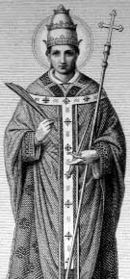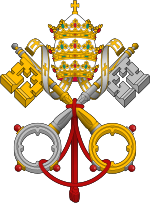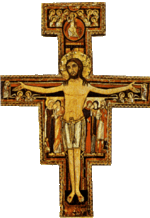Pope Alexander I
| Saint Alexander I | |
|---|---|
 |
|
| Papacy began | ca. 106 |
| Papacy ended | ca. 115 |
| Predecessor | Evaristus |
| Successor | Sixtus I |
| Personal details | |
| Birth name | Alexander |
| Born | unknown date Rome, Italy |
| Died | ca. 115 Rome, Italy |
| Other Popes named Alexander | |
| Papal styles of Pope Alexander I |
|
|---|---|
 |
|
| Reference style | His Holiness |
| Spoken style | Your Holiness |
| Religious style | Holy Father |
| Posthumous style | Saint |
Pope Saint Alexander I was Bishop of Rome from about 106 to 115. The Holy See's Annuario Pontificio (2008) identifies him as a Roman who reigned from 108 or 109 to 116 or 119. Some believe he suffered martyrdom under the Roman Emperor Trajan or Hadrian, but this is improbable.[1]
According to the Liber Pontificalis, it was Alexander I who inserted the narration of the Last Supper (the Qui pridie) into the Catholic mass. However, in the article on Saint Alexander I in the 1907 Catholic Encyclopedia, Thomas Shahan judges this tradition to be inaccurate. Both Catholic and non-Catholic experts accepts this regards this traditon as inaccurate[2]. It is viewed as a product of the agenda of Liber Pontificalis—this section of the book was probably written in the late fifth century—to show an ancient pattern of the earliest bishops of Rome ruling the church by papal decree.
Pope Alexander I is also said to have introduced the use of blessing water mixed with salt for the purification of Christian homes from evil influences, and the custom of mixing water with the sacramental wine. This too is considered unlikely,[1] as is the report that he ordained six priests, two deacons, and five bishops, since these offices are not thought to have been defined as such yet in his time. However, it is certainly possible that Alexander, whether acting singly or part of a collective leadership at Rome, played an important part in the governance of the church and the evolution of its emerging liturgical and administrative tradition.
A later tradition holds that in the reign of Emperor Hadrian, Alexander I converted the Roman governor Hermes by miraculous means, together with his entire household of 1500 souls. Saint Quirinus of Neuss, who was Alexander's supposed jailer, and Quirinus' daughter Saint Balbina were also among his converts.
Alexander is cited as having seen a vision of the infant Jesus.[3] In some editions of the Roman Missal the Saint Alexander commemorated on 3 May is identified with Pope Alexander I. This identification is not found in the Tridentine Missal promulgated by Pope Pius V in 1570. Since nothing is known of the Saints Alexander, Eventius and Theodulus of 3 May other than their names and the facts that they were martyred and were buried at the seventh milestone of the Via Nomentana on that day,[4] the one whose name coincided with that of a pope was identified with the Pope. The identification of the martyr Alexander with the Pope was removed from the Roman Calendar by Pope John XXIII in 1960.
His remains are said to have been transferred to Freising in Bavaria, Germany in AD 834.[2]
References
- ↑ 1.0 1.1 Encyclopaedia Britannica: Saint Alexander I
- ↑ 2.0 2.1 Catholic Encyclopedia: Pope St. Alexander I
- ↑ Visions of Jesus: Direct Encounters from the New Testament to Today By Phillip H. Wiebe. Oxford University Press. p. 20.
- ↑ Calendarium Romanum (Libreria Editrice Vaticana 1961), p. 122
Further readings
- Benedict XVI. The Roman Martyrology. Gardners Books, 2007. ISBN 9780548133743.
- Chapman, John. Studies on the Early Papacy. Port Washington, NY: Kennikat Press, 1971. ISBN 9781901157604.
- Fortescue, Adrian, and Scott M. P. Reid. The Early Papacy: To the Synod of Chalcedon in 451. Southampton: Saint Austin Press, 1997. ISBN 9781901157604.
- Jowett, George F. The Drama of the Lost Disciples. London: Covenant Pub. Co, 1968. OCLC 7181392
- Loomis, Louise Ropes. The Book of Popes (Liber Pontificalis). Merchantville, NJ: Evolution Publishing. ISBN 1889758868
External links
| Catholic Church titles | ||
|---|---|---|
| Preceded by Evaristus |
Bishop of Rome Pope 106–115 |
Succeeded by Sixtus I |
|
|||||||||||||||||||||||||||||||||||||||||||||
|
|||||||||||||||||||||||||||||||||||||||||

